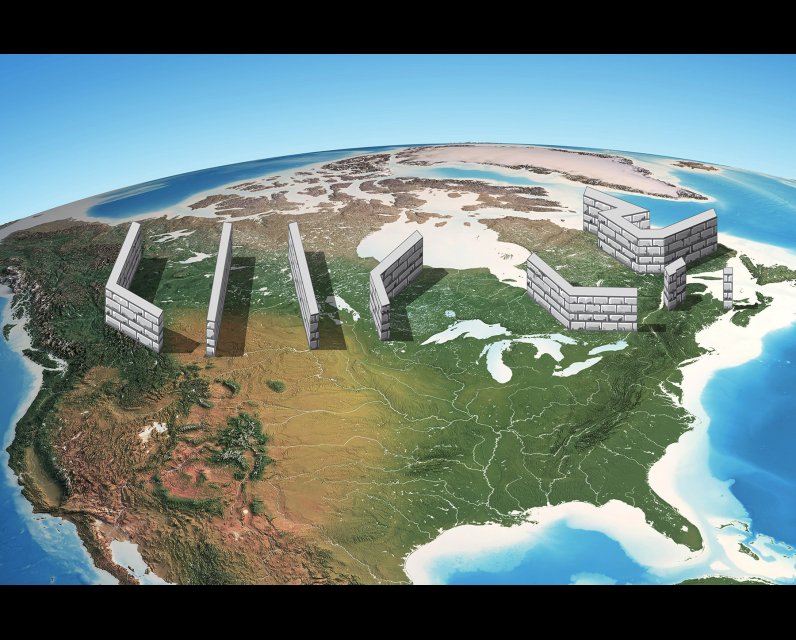Source Feed: Walrus
Author: Hailey Choi
Publication Date: April 17, 2025 - 10:30
Canadians Want to Buy Local. Their Provinces Make It Hard
April 17, 2025

Angry and frustrated by US president Donald Trump’s ever-changing tariff threats, Canadians are ditching American products in favour of local options. People want to buy all things Canadian—but what if Canada is getting in its own way? As the federal government pushes to strengthen the economy, long-standing interprovincial trade barriers could make it harder to do business across the country. From alcohol restrictions to professional licensing rules, calls to “break down walls” and improve trade between provinces are gaining new momentum.
To unpack what this means, we spoke with Philip Holdsworth, a litigation lawyer at Toronto-based law firm Robins Appleby, who has written about free trade within Canada.
Can you explain what interprovincial trade barriers are?
They are what’s referred to as non-tariff barriers: barriers that aren’t a direct tax on a service or a good that increases its cost but a regulation that differs between two jurisdictions.
Article 121 of the Canadian Constitution deals with the fact that there should be a free flow of goods between the provinces. That’s been interpreted to mean you can’t put a tariff on a good transporting between British Columbia and Ontario or Nova Scotia and Manitoba. But every province is responsible for property, goods, services, and the laws at a local level, so regulations in how you do business from one place to the next can become a barrier that results in a higher cost to the producer or the service provider. And the increased costs are inevitably passed on to consumers.
How does interprovincial trade compare to international trade? Have these barriers affected provincial trading relationships with the US?
So we’ve seen a decline in the amount of interprovincial trade since the ’80s and an increase in international trade. And a part of that is because trade was liberalizing globally, which has reduced the cost of doing business outside of Canada. And there had been stagnation in the reduction of those barriers inside the country.
The way I think about it is like this: if it’s easier for a business in Alberta to sell its products or services south of the border versus Ontario because the regulatory burden is lower, then they’re going to do that. NAFTA really opened up a long period of liberal trade with the US, and the Canada–European Union Comprehensive Economic and Trade Agreement also reduced trade barriers. And while Europe is generally a much more pro-regulation jurisdiction, the same principle applies: businesses will sell their goods and services to the jurisdiction that they can get the best price for. It’s been easier for businesses to expand outside of Canada than for them to expand internally.
What are some examples of these barriers, and how do they impact Canadians?
A big example is found in the alcohol industry. Each province regulates liquor and sets rules governing how alcohol can be imported, distributed, and sold. These differences can restrict out-of-province producers from accessing other provincial markets. If you want to buy beer from another province, it is going to cost you more. That’s not actually a product of the fact that it’s coming all the way from Nova Scotia or Ontario; it’s a product of provincial regulation that’s designed to prop up and protect the microbrewery industry in those provinces. In 2017, an Alberta-based beer importer arbitrated a dispute with the province of Alberta over a program which imposed markups on craft beer while introducing a grant program to offset the markup for Alberta brewers, creating an uneven playing field. The panel ruled that Alberta’s policy violated the non-discrimination provisions of the Agreement on Internal Trade. The case underscored how such indirect barriers and preferences can affect the market.
Another example is the provincial regulation of professional credentials—a frequent source of friction. Several disputes have dealt with the mutual recognition of accounting credentials between provinces. In one case, Ontario’s refusal to recognize the credentials of accountants from other provinces was ruled to be a breach of the labour mobility provisions of the AIT. That case set a precedent.
And so differences in regulations—how we regulate nurses or accountants or lawyers—those differences form this type of invisible hurdle for those types of service providers to be able to move to another jurisdiction and provide services there. There are hundreds of professional regulatory bodies across the country. These differing regulatory regimes can increase barriers.
A deal has now been made to allow Canadian alcohol to freely move across the country. What can consumers expect from that?
We will start to see a wider selection. I wouldn’t be surprised if a lot of Ontario consumers aren’t even aware of the breadth of diversity in Canadian alcohol. But it’s analogous to every other industry we have in all these provinces.
The Canadian Free Trade Agreement has been in place with the provinces since 2017. Was that the first big move from the government to eliminate barriers?
The agreement actually has its origins in the 1960s. Provinces started to realize that agricultural subsidies and supply-side markets were creating these interprovincial trade barriers and that it was potentially harming competition. But because there was an absence of authority from our constitutional structure on how to address these challenges, provinces effectively had to come together and agree with each other outside of the Constitution to a commitment to reducing these trade barriers.
In 1994, they signed the AIT, an agreement between the provinces designed to enhance internal trade and harmonize regulations so that we could enhance competition interprovincially. In 2017, the AIT was amended and changed to the CFTA.
If we’ve had a trade agreement in place for decades, why is this still such an issue?
The provinces had a whole bunch of carve-outs for protection in the agreement. The list is quite extensive. It’s a block of cheese with many holes in it. Each jurisdiction has specific exemptions for industries and policies that they are trying to protect.
There are also government procurement exceptions. For example, Ontario excludes procurement for poverty reduction programs under $200,000—which means that a company outside of Ontario would not be able to bid on, say, a co-operative housing program under that amount. That money is reserved for businesses in that province.
Provinces have their own reasons to implement these policies, while at the same time being committed to trying to drive down the cost of interprovincial trade.
Another way provinces could streamline things is through mutual recognition of each other’s regulations and licensing standards; this has been mentioned a lot as a solution. What does that mean?
Mutual recognition goes back to this concept of trying to harmonize regulations and regulatory licensing standards and recognizing them as equivalent. For example, all accountants are licensed provincially. But the general accounting principles are pretty much uniform across Canada, so having regulatory hurdles that require them to recertify themselves in a different province doesn’t really make sense. There’s no reason to think that the regulatory body that licenses accountants in Ontario is less qualified than the same body in British Columbia or somewhere else.
The idea of mutual recognition is for provinces to agree where they can and to be much more streamlined in terms of increasing competition. The concept would also apply to things like labelling and certain environmental standards.
But some people argue that mutual recognition can be harmful.
So mutual recognition can potentially create a race to the bottom. The risk is that, let’s say, Alberta has lower environmental regulations for its providers. And if the lowest common denominator of regulations applies interprovincially, then the provinces lose their ability to legislate environmental protection for their provincial residents. The real objective of mutual recognition is to try to reduce the differences where they are unnecessary while still respecting the provinces’ right to regulate.
Recently, the first ministers made an announcement that they’re going to be eliminating internal trade barriers. Have you seen a push like this before?
I don’t think I’ve seen this public of a push before. There’s been this ebb and flow of the provinces’ commitment. It’s cropped up here and there on different issues and from time to time.
And now, this renewed pressure and commitment by the provinces to lower those barriers will mean that the spotlight will be on these carve-outs or exceptions that the provinces have made for themselves.
In February, Anita Anand, then minister of transport and internal trade, suggested provincial trade barriers could be wiped away in thirty days. What do you think?
It’s not going to happen that quickly. They are non-tariff barriers. They are “invisible.” The ministry and the provinces have a general recognition of the areas where there is restricted trade and where there are persistent ongoing issues, but the full scope of these different barriers is not readily apparent.
Will removing the barriers be enough to address the US tariffs?
I think it will be an effective tool. Where the path to selling stuff to our neighbours in the south is made more expensive, we can turn to each other, start competing more effectively, and drive costs down.
But it’s not a panacea; given how significant the US is as a trading partner, it’s not going to fill the entire gap. But that, combined with looking to other trading partners in Europe and elsewhere, will help fill a big hole resulting from the drop in trade due to Trump tariffs. The post Canadians Want to Buy Local. Their Provinces Make It Hard first appeared on The Walrus.
Pope Francis, who served in the position for 12 years, passed away Monday morning at the age of 88. As some Ottawans arrived to church for their Easter Monday morning mass, they still hadn't heard the news.
April 22, 2025 - 10:51 | | CBC News - Ottawa
The Conservative Party platform promises to cut $10.5 billion in spending on outside consultants for the federal public service, and shrink the government workforce through attrition. Read More
April 22, 2025 - 10:41 | Matteo Cimellaro | Ottawa Citizen
How many politicians does it take to fix Canada’s housing shortage? The answer, apparently, is all of them. Read More
April 22, 2025 - 10:39 | Christina Spencer, Ottawa Citizen | Ottawa Citizen




Comments
Be the first to comment